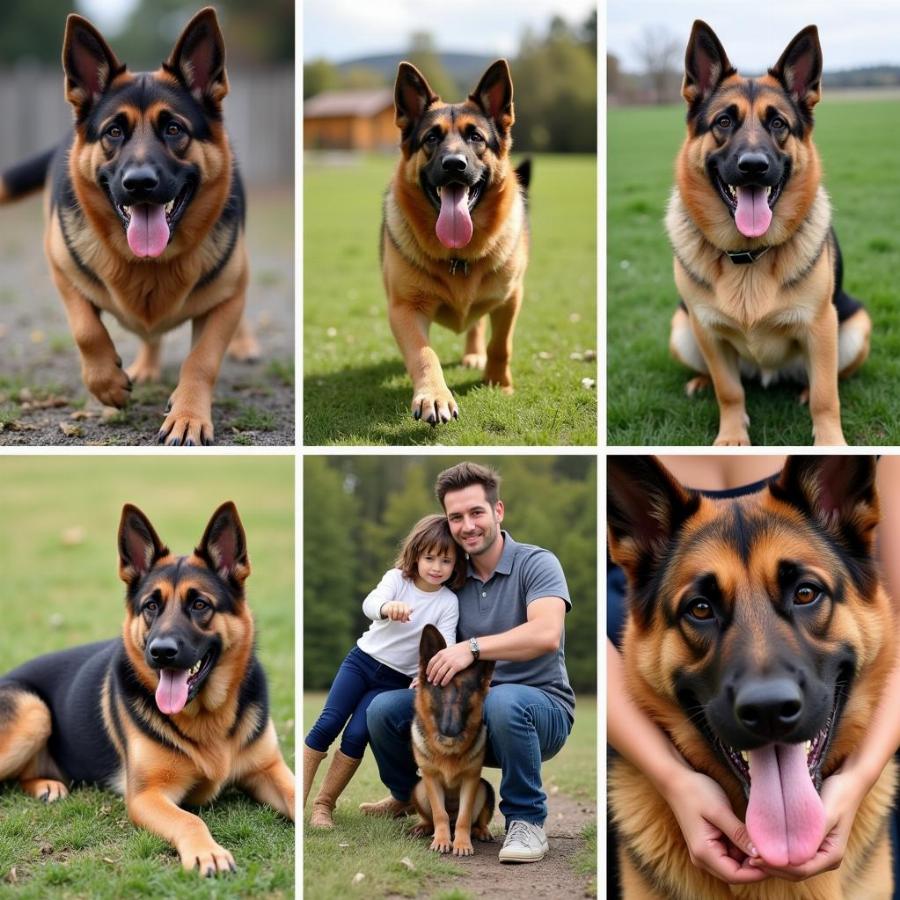German Shepherd Dogs (GSDs) are a popular breed known for their intelligence, loyalty, and versatility. But did you know there’s more than one type of German Shepherd? Understanding the different types of German Shepherd dogs can help you choose the right companion for your lifestyle and needs. From working lines to show lines, this article dives into the diverse world of GSDs, exploring their unique characteristics and variations.
Decoding the Different German Shepherd Lines
The term “types” of German Shepherd Dogs often refers to different breeding lines, each emphasizing specific traits. These lines have developed over time based on their intended purpose, whether it be for work, show, or companionship. Understanding these distinctions helps prospective owners make informed decisions. The primary distinctions lie between working line, show line, and American show line German Shepherds.
Working Line German Shepherds
Working line GSDs are bred for their intelligence, drive, and trainability. They excel in demanding roles like police work, search and rescue, and protection. These dogs are highly energetic and require significant physical and mental stimulation. Their appearance can vary, but they typically have a straighter back than show lines.
Show Line German Shepherds
Show line GSDs are bred for their adherence to breed standards, focusing on physical appearance and conformation. They are known for their sloped back and elegant gait. While still intelligent, their drive for work might be less intense than working lines. They are often seen in conformation shows and can make wonderful family companions for owners who can provide adequate exercise and mental stimulation.
American Show Line German Shepherds
The American show line has further diverged from the German show lines, prioritizing a more extreme sloped back and often a more refined head shape. This exaggerated angulation can sometimes lead to health concerns. It’s important to research reputable breeders who prioritize health and temperament alongside conformation.
West German Show Line vs. East German DDR German Shepherds: Key Differences
Beyond the broad categories of working and show lines, there are further distinctions within German Shepherd lineages. A key historical distinction is between the West German Show Line and the East German DDR (Deutsche Demokratische Republik) German Shepherds. These two lines developed in isolation due to the division of Germany after World War II.
West German Show Line GSDs
These are the dogs commonly seen in conformation shows today. They possess the characteristic sloped back and are bred for their striking appearance.
East German DDR GSDs
Bred under stricter guidelines in East Germany, DDR GSDs were primarily focused on working abilities. They are known for their robust build, straight back, darker coat color, and strong work ethic. DDR GSDs are often sought after for their resilience and trainability.
Choosing the Right German Shepherd for You
With so many different types of German Shepherd dogs, how do you choose the right one for you? Consider your lifestyle, experience with dogs, and what you expect from your canine companion.
- Activity Level: Working lines require substantial exercise and mental engagement. Show lines, while still active, may be a better fit for a less demanding lifestyle.
- Training Experience: Working lines can be a challenge for first-time dog owners due to their high drive.
- Living Situation: A large, secure yard is ideal for any GSD, especially working lines.
- Health Considerations: Research breeders carefully to minimize the risk of breed-specific health issues, especially in American show lines with exaggerated angulation.
 Choosing the Right German Shepherd
Choosing the Right German Shepherd
Conclusion
Understanding the different types of German Shepherd dogs is crucial for choosing the right companion. Whether you’re drawn to the working ability of a working line, the elegance of a show line, or the historical significance of a DDR GSD, researching the specific characteristics of each line will ensure a harmonious partnership. Choosing the right type of German Shepherd dog will lead to a fulfilling and rewarding experience for both you and your furry friend.
FAQ
- What is the most common type of German Shepherd? The West German Show Line is the most commonly seen type in conformation shows and as pets.
- Are all German Shepherds good family dogs? With proper training and socialization, German Shepherds can make excellent family dogs, but working lines may be too demanding for some families.
- Do different German Shepherd types have different temperaments? While temperament can vary within any breed, working lines tend to be more driven and energetic than show lines.
- What are the health concerns associated with different GSD lines? Hip and elbow dysplasia are common concerns in all lines, while American show lines can be prone to issues related to their exaggerated back angulation.
- Where can I find a reputable breeder of a specific German Shepherd type? Research breed-specific rescue organizations and contact national breed clubs for recommendations on reputable breeders.
- How much exercise does a German Shepherd need? German Shepherds require substantial daily exercise, both physical and mental.
- Are different German Shepherd types more prone to certain behaviors? Working lines may be more prone to herding or protective behaviors if not properly trained and socialized.
Looking for more information on specific dog breeds? Check out these related articles:
Beaut Dogs is your trusted source for all things related to dog breeds. We provide comprehensive information, expert advice, and valuable resources to help you navigate the world of dog ownership. For personalized support and answers to your specific questions, reach out to us via Email: [email protected]. Beaut Dogs is committed to helping you find the perfect canine companion and build a strong, lasting bond.